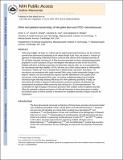DNA-templated assembly of droplet-derived PEG microtissues
Author(s)
Li, Cheri Yingjie; Wood, David K.; Hsu, Caroline M.; Bhatia, Sangeeta N.
DownloadBhatia_DNA-templated.pdf (1.670Mb)
OPEN_ACCESS_POLICY
Open Access Policy
Creative Commons Attribution-Noncommercial-Share Alike
Terms of use
Metadata
Show full item recordAbstract
Patterning multiple cell types is a critical step for engineering functional tissues, but few methods provide three-dimensional positioning at the cellular length scale. Here, we present a “bottom-up” approach for fabricating multicellular tissue constructs that utilizes DNA-templated assembly of 3D cell-laden hydrogel microtissues. A flow focusing-generated emulsion of photopolymerizable prepolymer is used to produce 100 μm monodisperse microtissues at a rate of 100 Hz (10[superscript 5] h[superscript −1]). Multiple cell types, including suspension and adherently cultured cells, can be encapsulated into the microtissues with high viability ([similar]97%). We then use a DNA coding scheme to self-assemble microtissues “bottom-up” from a template that is defined using “top-down” techniques. The microtissues are derivatized with single-stranded DNA using a biotin–streptavidin linkage to the polymer network, and are assembled by sequence-specific hybridization onto spotted DNA microarrays. Using orthogonal DNA codes, we achieve multiplexed patterning of multiple microtissue types with high binding efficiency and >90% patterning specificity. Finally, we demonstrate the ability to organize multicomponent constructs composed of epithelial and mesenchymal microtissues while preserving each cell type in a 3D microenvironment. The combination of high throughput microtissue generation with scalable surface-templated assembly offers the potential to dissect mechanisms of cell–cell interaction in three dimensions in healthy and diseased states, as well as provides a framework for templated assembly of larger structures for implantation.
Date issued
2011-07Department
Harvard University--MIT Division of Health Sciences and Technology; Massachusetts Institute of Technology. Department of Chemical Engineering; Massachusetts Institute of Technology. Department of Chemical EngineeringJournal
Lab on a Chip
Publisher
Royal Society of Chemistry, The
Citation
Li, Cheri Y. et al. “DNA-templated Assembly of Droplet-derived PEG Microtissues.” Lab on a Chip 11.17 (2011): 2967.
Version: Author's final manuscript
ISSN
1473-0197
1473-0189